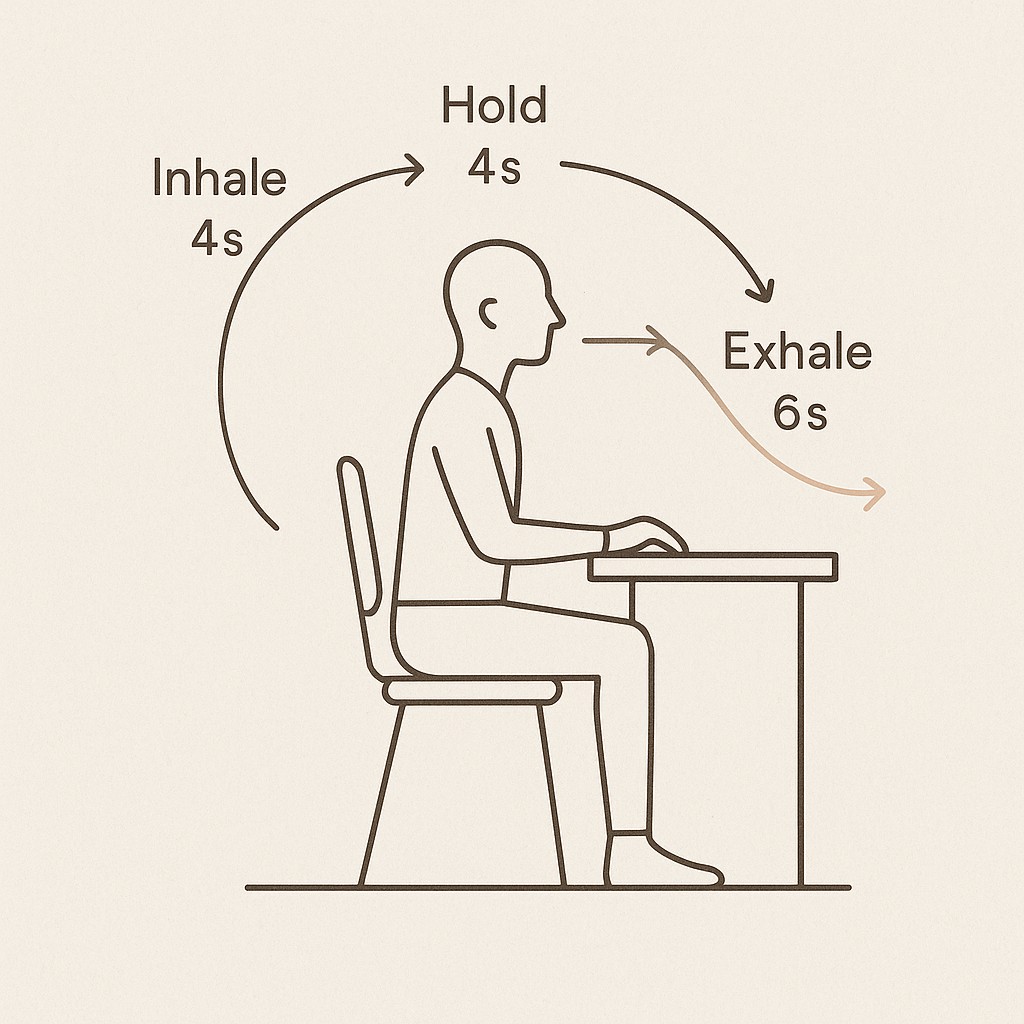Calm Stress With Breathing: A Quick Desk Reset for Engineers
Calm Stress With Breathing: A Quick Desk Reset for Engineers

A Quick Reset: Calm Stress With Breathing at My Desk
It hit on a Wednesday afternoon. That cold that sneaks in under the office door still somehow managed to show up at the tail end of March. I was keyed up, mentally spinning from too many open threads. My body, on the other hand, was lagging behind—tight chest, shallow breath, that wired-but-tired feeling. It’s the kind of physical alert that’s hard to ignore. That’s when the small mistakes start slipping in. Or I catch myself re-reading the same line of code, over and over, as if repetition might force clarity. If you know this sensation, it’s more than distraction—it’s the early warning that a stress loop is about to run the show.
Normally, I’d get up and walk it off, but I’ve learned to calm stress with breathing before I even leave my chair. But that day, the chill boxed me in. I wanted to go for a walk to clear my head, but it’s still too chilly out. A half-thought about grabbing another coffee flashed through my mind. I didn’t, but I still have this weird superstition that a change in caffeine might help, even though I KNOW it never does. Anyway, waiting it out doesn’t fix anything. If you’re stuck in the fog, you have to break the pattern right where you’re sitting.
So I turned to my fallback: 2 minutes of deep breathing. Inhale for four. Hold for four. Exhale for six. I’ve leaned on this for years now. When the weather or timing isn’t right for a walk, it’s oddly reliable for clearing the stress signal at my desk. The longer exhale, especially, does the trick—it’s enough to start a shift from frazzled to steady, right there.
That’s it. No app. No timer. Just breathing with attention, making each exhale slow and audible enough that I can actually feel the release—almost like flipping a switch from tense to present.
Yes, I seriously do this. And it works. Every time.
Why Stress in Engineering Is a Body Problem—And What to Do About It
Stress lives in your body. So does the solution. If you’re feeling foggy or tense, it’s not just your head that’s in trouble.
I’ll be honest, six months ago I assumed I could power through the crunch with sheer grit. But deadlines stack up, context switches keep multiplying. A reminder, too: watch your information diet. These days, by noon, I can feel my shoulders creeping up like they’re bracing for impact. This isn’t unique—all of us in engineering ride this train.
The pattern is pretty familiar now. Engineers and AI folks charge through hours of problem-solving, which is why breathing exercises for engineers matter while bouncing between Slack notifications, PRs, actual building. Over time—and sooner than I used to realize—my breath gets shallow. It’s weird; you don’t notice it happening. As inhalation shortens and exhale fades, the sympathetic nervous system kicks in. Working memory lags, decision fatigue creeps in, and suddenly I’m second-guessing calls I’d trust any other day. Even pacing your breath at 5–6 times per minute—no gadgets, no tricks—can trigger genuine shifts in your autonomic function. No awards for toughing it out; just your brain running low.
So thinking gets foggy, choices get riskier. I swing from crisp triage to chasing issues in circles—like what happened on that cold Wednesday. Luck won’t fix it. Waiting won’t, either. This pattern you can actually interrupt.
What helps most: next time you feel tension or that wired exhaustion creeping in, reduce stress with breathing—don’t ignore it. Pause. Take a minute (or stretch it out longer). Inhale, hold, then let your exhale run longer than the breath in. It really does take less time than checking notifications, and flips your state before you make a move you regret.
How Breathing Interrupts the Stress Cycle—A Simple Physiological Play
When stress spikes, breathing exercises for stress make sense because things don’t just go sideways in your mind. Your body flips into “go mode” and the sympathetic nervous system grabs the wheel—heart rate jumps, muscles stiffen, breathing goes ragged. The fastest lever to pull isn’t a clever thought; it’s your breath.
Deliberate, slow breathing—often called parasympathetic breathing—taps into your parasympathetic system. Inhale: vagal control drops. Exhale: vagal tone comes back online, heart rate dips, and the rest of you can finally start to decompress source. That’s the pivot I go for every time.
It’s the longer exhale that’s key—more feathering the brakes than stomping. You’re sending the signal: we’re safe, you can stand down. Heart rate variability lands in a useful range again, and the haze clears just enough for you to make clear sense of what’s next. Forget the zen or mini-meditation angle. Manuals usually set the window at 4.5 to 6.5 breaths per minute—for calming HRV, it keeps things simple source. It appeals to me because it’s mechanical, repeatable, visible. With deep breathing for focus, shoulders drop, breath deepens, and focus returns. Doesn’t matter how busy the day is—the reset is real.

I know this is nerdy, but I think of it as taming the event loop—a little less jitter, throughput steadies out. Maybe corny, but the analogy actually fits. The loop recovers, so do you.
Here’s what to do when tension spikes or the fog hits: pause, intentionally sit upright, and run this pattern—inhale for four seconds, hold for four, exhale for six. Counting in your head works fine. A single cycle runs about 14 seconds. You only need a handful.
Repeat for a few cycles—one minute, maybe up to three if it’s a tough spot. Shoulders drop, breath eases, you’ll feel it. The system resets. When it lands, I take a quick 60-second self-check before diving into whatever task’s next link. That’s the loop-breaker I trust.
Integrating the Breathing Reset Into Your Workflow
You know the early warnings—the jaw tightening, fast tab switches, tight chest, maybe a pulse you weren’t tracking before. Catch them before they cascade. That’s really the moment to pause, not push through. I keep doing this: a short breath reset BEFORE the spiral saves hours of messy work or decisions later. Everybody has their signposts if they’re honest.
Here’s my process: first, fix your posture—upright, feet flat. Inhale for four, actually fill your lungs. Hold for four, let the pause settle. Exhale gently for six, make it an audible release. I sometimes exaggerate it—partly so I hear the shift start, partly because there’s a strange satisfaction in sending that signal out. Your gaze softens, maybe close your eyes for a tick. Run the pattern four or five times—one or two minutes. Then check in. Are shoulders lower? Chest softer? Mental clarity returning? If so, green light to move on. Or you can take device-free stillness breaks if that suits you better than breath work. It’s about resetting without fanfare—then straight into debugging or calls as needed.
If you worry about needing “ideal” conditions—headphones, privacy, an app—I get that. You don’t, though. Simplicity is the feature. All you need is a chair and your attention for two minutes. I’ll admit, I used to overcomplicate it. Now I treat it like refreshing a tab: quick, direct, always ready.
A callback to earlier—the audible exhale is how I know it’s landing. Right before dialing into an incident call, I do two longer-exhale cycles, sometimes letting the sound linger. The shift is unmistakable—tension fades, focus locks in. You show up present, not scattered.
One last thing, and maybe I should have said this at the top—I still occasionally push past the warning signs, even now. Old habits thread deep. I know I shouldn’t, but I do.
Does a Quick Breathing Reset Really Pay Off?
Let’s be practical about time. I know most people ask, “Should I really interrupt my flow for this?” My answer, after running my own data for months, is yes. Two minutes is nothing compared to cleaning up mistakes brought on by mental fog, backtracking through fuzzy meetings, or chasing decisions I’m not proud of. This is ROI—not a ritual: fast breath resets save more output than they ever cost, and I bet they protect your short deep work sprints as much as your focus. If you’ve ever had to fix a bug you know you introduced while distracted, or found yourself explaining the same point twice in a call, you already know which side gets the win.
So here’s my proposal. Commit to the pause. Anytime you notice tension—clenched shoulders, racing thoughts—stop, give one to three minutes to your breath, then step back in. Just like you’d scan logs after an error, or check config before deploy.
Stress always parks somewhere in your body, but you can calm stress with breathing—it’s the lever within reach. Make it slow, make your exhale longer, and you’ll clear your system for what’s next.
Engineers and AI builders, generate AI-powered drafts for status updates, docs, and posts in minutes, so you share clear work without context-switching or overthinking.
If you’re waiting for the perfect moment, you’ll miss it. Just breathe, reset, and move on.
Enjoyed this post? For more insights on engineering leadership, mindful productivity, and navigating the modern workday, follow me on LinkedIn to stay inspired and join the conversation.
You can also view and comment on the original post here .
